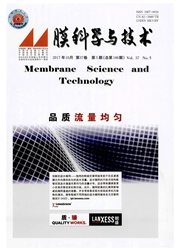

 中文摘要:
中文摘要:
基于Donnan渗析原理,采用阴离子交换膜无电压作用下分离饮用水中Cr(Ⅵ).结果表明,当原水中Cr(Ⅵ)初始浓度为1.0 mg/L,pH值为6.95,补偿溶液NaCl浓度为0.1 mol/L,原水和补偿溶液进水流量均为2.5 mL/min,膜两侧溶液搅拌强度为500 r/min,水温为25℃时,阴离子交换膜对Cr(Ⅵ)的分离去除率为86.4%.采用Na2 SO4作为补偿溶液时,Cr(Ⅵ)的分离去除效果降低.调节原水pH值至11.0时,阴离子交换膜对Cr(Ⅵ)的分离去除率下降至78.9%.提高膜两侧溶液搅拌强度,给体池中Cr(Ⅵ)更容易通过膜迁移分离至受体池中.水温由10℃升高至40℃,给体池中Cr(Ⅵ)剩余质量浓度由0.21 mg/L下降至0.12mg/L.
 英文摘要:
英文摘要:
The separation of Cr( Ⅵ ) from drinking water by anion-exchange membrane was investigated based on Donnan dialysis principle without supplying electrical potential. The results show that the separation efficiency of Cr(VⅥ) by anion-exchange membrane can achieve 86. 4% under the conditions of influent Cr(Ⅵ) of 1.0 mg/L, initial pH of the feed solution of 6.95, NaCl concentration of 0. 1 mol/L in the counterion solution, flow rate of the feed and counterion solution of 2. 5 mL/min, stirring speed of 500 r/min, and phase temperature of 25 ℃. Using Na2SO4 solution as the counterion solution, the separation efficiency of Cr(Ⅵ) reduces. Adjusting initial pH of the feed solution to 11.0, the separation efficiency of Cr(Ⅵ) by anion-exchange membrane decreases to 78. 9%. Increasing stirring speed of the two solutions beside the membrane, Cr (Ⅵ) in the feed chamber is more easily transferred to the receiver chamber through anion-exchange membrane. When phase temperature increases from 10 ℃ to 40 ℃, the residual Cr(Ⅵ) concentration in the feed chamber decreases from 0. 21 mg/L to 0. 12 mg/L.
 同期刊论文项目
同期刊论文项目
 同项目期刊论文
同项目期刊论文
 期刊信息
期刊信息
